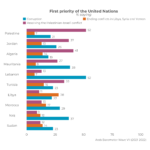Despite a growth in fatalities resulting from organized violence with Shia–Sunni dimensions over the last two decades, in this study, we show, using existing data-bases on interreligious dialogue and peacemaking, that only less than two percent of the interreligious peacemaking organizations in the world are specialized in dialogue between Shias and Sunnis. Why is there so little institutionalized Shia–Sunni dialogue occurring when the need for such dialogue is evident? This study identifies and discusses this lack of institutional initiatives designed to prevent violence, manage conflicts and facilitate processes of intra-Muslim de-sectarianization. We discuss what we see as the three seemingly most obvious explanations—(1) the dismissal of the relevance of a Shia–Sunni cleavage, (2) the inappropriateness of the interreligious dialogue concept in the Muslim context, and (3) the substitution of institutional interreligious dialogue by other channels. Although we suggest that the third is the most potent explanation to pursue, we do not aim to provide a comprehensive explanation for the Shia–Sunni religious dialogue deficit. Instead, our aspiration is mainly to present and substantiate a puzzle that has not been identified or discussed in previous research. This can set an agenda for a reinvigorated research endeavor into the contemporary challenges for interreligious peacemaking.
View External Site
Topics
- Charity2
- Corruption113
- COVID-1969
- Democracy35
- Discrimination13
- Economy226
- Education51
- Environment36
- Extremism19
- Freedoms50
- Gender Issues159
- Governance253
- Health44
- International Relations193
- Labor Market35
- Media31
- Migration63
- Political Institutions213
- Political Participation33
- Political Systems60
- Refugees6
- Religion118
- Security31
- Social Justice44
- Wellbeing2
- Youth75


